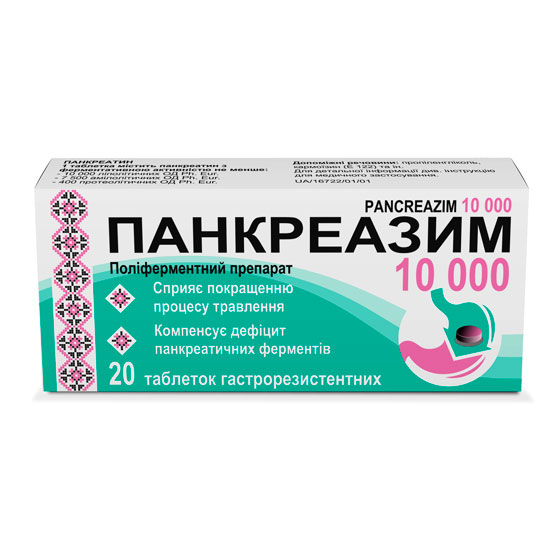
Pancreazim 10000
Pancreazim 10000Pharmacotherapeutic group. Means that affect the digestive system and metabolism. Agents that improve digestion, including enzymes. Polyenzyme preparations (lipase, protease, etc.). ATX code A09A A02.
Composition
Active ingredient: pancreatin; 1 gastro-resistant tablet contains pancreatin with enzymatic activity of at least 10,000 lipolytic OD Ph. Eur., 7,500 amylolytic OD Ph. Eur., 400 proteolytic OD Ph. Eur.; excipients: sodium chloride, silica colloidal anhydrous, cellulose microcrystalline, crospovidone, sodium croscarmellose, povidone 25, magnesium stearate, methacrylate copolymer dispersion, talc, propylene glycol, titanium dioxide (E 171), carmoisine (E 122).
Pharmacological properties
Pharmacodynamics. Polyenzyme preparation. Pancreatic enzymes (lipase, amylase and protease), which are part of it, facilitate the digestion of fats, carbohydrates, proteins, which contributes to their complete absorption in the small intestine. In diseases of the pancreas, the drug compensates for the insufficiency of its external secretory function and improves the digestive process.
Pharmacokinetics. The shell covering the tablet does not dissolve under the action of gastric juice and protects enzymes from their inactivation by gastric juice. Only under the action of a neutral or slightly alkaline medium of the small intestine does the shell dissolve and release enzymes.
Indications for use (instruction): Pancreazim 10000
Diseases that are accompanied by a violation of the process of digestion of food due to insufficient release of digestive enzymes by the pancreas, such as chronic pancreatitis. Conditions after simultaneous resection of the stomach and small intestine, functional acceleration of the passage of food through the intestine, intestinal disorders, simultaneous use of difficult-to-digest plant, fatty and unusual foods. Swelling of the intestine. Preparation for radiological or ultrasound diagnostic tests.
How to use
The dose of the drug depends on the deficiency of pancreatic enzymes in the duodenum and is set individually.
If there are no other recommendations, as well as in the case of consuming difficult-to-digest plant foods, fatty or unusual foods, take 1-2 tablets. In the other above cases, when digestive disorders occur, the recommended dose is 2-4 tablets. If necessary, the dose of the drug can be increased. Increasing the dose in order to reduce the symptoms of the disease, for example, steatorrhea or abdominal pain, should be carried out only under the supervision of a doctor. The daily dose of lipase should not exceed 15,000-20,000 U of P. Eur. per 1 kg of body weight.
Take tablets while eating, swallowing whole and drinking a significant amount of liquid, for example 1 glass of water. The duration of treatment depends on the course of the disease and is determined by the doctor individually.
Children
There is no experience in using the drug for children, therefore it is not recommended to prescribe it to this age category of patients.
Contraindications
Hypersensitivity to the active substance and other components of the drug. Acute pancreatitis, exacerbation of chronic pancreatitis, intestinal obstruction.
Overdose
Symptoms. It is possible to increase side effects. While taking extremely high doses of other drugs from pancreatic powder, hyperuricemia and hyperuricosuria were observed.
Treatment. Discontinuation of the drug, sufficient hydration and symptomatic therapy.
Adverse reactions
To assess the frequency of adverse reactions, the following classification is used: very often: ≥ 1/10; often: ≥ 1/100 and < 1/10; infrequent: ≥ 1/1000 and < 1/100; rare: ≥ 1/10000 and < 1/1000; very rare: < 1/10000, frequency unknown (not assessable).
Cardiovascular: unknown frequency: tachycardia.
From the side of the immune system: very rare: allergic reactions of immediate type (skin rash, itching, sneezing, watery eyes, bronchospasm), anaphylactic reactions. The frequency is unknown: the dye karmoisin (E 122) can cause allergic reactions.
From the gastrointestinal tract: very rare: with high doses of pancreatin (more than 10,000 U P. Eur. lipases/kg body weight/day) can form narrowing in the ileocecal region and in the ascending part of the colon; diarrhea, abdominal pain, nausea, vomiting, changes in the nature of stools; possible development of intestinal obstruction, constipation.
Skin and subcutaneous tissues: unknown frequency: urticaria, flushing, itching, angioedema.
On the part of the genitourinary system: the frequency is unknown: increased uric acid excretion in the urine is possible, especially with high doses of pancreatin. To avoid the formation of uric acid concrements in such patients, the uric acid content in the urine should be monitored.
Common disorders: frequency unknown: feeling of heat, general weakness.
Release form
Gastro-resistant tablets.
Packaging. 10 tablets in a blister. 1 or 2, or 5 blisters in a cardboard pack.
Storage conditions
Store in the original packaging at a temperature not exceeding 25 ºС. Keep out of the reach of children.
Manufacturer
PJSC "Technologist", Ukraine, 20300, Cherkasy region, Uman city, Staraya proreznaya street, 8.
Registration certificate
UA / 16722/01/01

This section of the website contains information about medicines, their properties, and methods of use. The information contained in this section is not intended as a guide for self-diagnosis and/or treatment. LLC «Universal Agency «PRO-PHARMA» is not responsible for any negative consequences that may arise from the independent use of the information in this section. By using the information in this section, you do so at your own risk, understanding that self-medication can be harmful to your health.